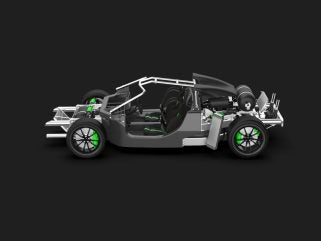
Decarbonisation, reducing the carbon footprint and opting for alternative, cleaner fuel is at the top of the agenda for automotive OEMs. With many switching to the production of EVs over ICE vehicles, others are looking further ahead.
Technology and engineering service business, Fortescue (FWAE), revealed its latest hydrogen fuel cell electric vehicle innovation at CENEX Low Carbon Vehicle (LCV) Show. Named EVRh, the battery in the platform concept is capable of discharging 430kW of power. Combined with the 120kW hydrogen fuel cell, EVRh has a total output of 550kW.
The vehicle platform has been developed to showcase the potential of hydrogen as a fuel for the automotive industry, utilising an H2 fuel cell system, to produce electricity through a chemical reaction between hydrogen and oxygen in a fuel cell stack.
We spoke to Sam Dew, project engineer, battery integration, WAE Technologies, to discuss the EVRh and what it could mean for the industry.

Just Auto (JA): Could you discuss the background to the company?
Sam Dew (SD): WAE, which was formerly Williams Advanced Engineering, was founded in 2010 as a spin-off from Williams Formula One. It operated for most of its time as an engineering consultancy, taking some technology from Formula One and then adapting that to other applications.
How well do you really know your competitors?
Access the most comprehensive Company Profiles on the market, powered by GlobalData. Save hours of research. Gain competitive edge.

Thank you!
Your download email will arrive shortly
Not ready to buy yet? Download a free sample
We are confident about the unique quality of our Company Profiles. However, we want you to make the most beneficial decision for your business, so we offer a free sample that you can download by submitting the below form
By GlobalDataOur electrification programme has been running since the start. One of our first programmes was working on the hybrid systems for Williams Formula One. We’ve always been involved in electrification programmes and we’ve ultimately taken that forward to grow our specialisation in battery technology, which has been ongoing now for several years.
From a WAE perspective we’ve become known for motorsport technology. We produce battery packs for Formula E; we make the current battery packs and we made the first battery packs. We also do a series of other sport batteries. As a company, we’ve always thrived on developing that really high value technology, bringing it to higher volume production type applications, and that’s what we’re ultimately doing.
In 2019, a majority stake of the company was bought by an investment company called EMK, then the company was bought fully by Fortescue, which is the fourth largest iron ore mining company in the world. They are based in Western Australia. We are now fully owned by them.
The reason that came about was because we were doing a project for them. We were developing a battery system for one of their mining haul trucks. We retrofitted a battery system to ultimately prove our battery technology in a mining application. That programme has been pretty successful. The prototype vehicle is currently running in Perth and I think it’s the first of its kind to be a fully operational battery electric mining haul truck. It is using a 1.4 megawatt hour (MWh) battery, which we believe is one of the largest moving vehicles on rubber tyres to be fully electrified.
What about the EVRh – what is the thinking there?
EVRh is a hydrogen, high performance vehicle platform. It’s a concept vehicle, essentially. For us internally it acts as an R&D tool that we are able to develop hydrogen technology from.
One year prior to unveiling EVRh, we unveiled our EVR platform. That was a fully battery electric platform that was effectively taking experience from various hypercar EV programmes that we’ve been involved in, most notably the Lotus Evija programme.
Ultimately that was a rolling chassis that other customers would be able to effectively design their own high-performance vehicle around. So essentially, we had a rolling chassis as a starting point. We knew that we wanted to be able to offer a wider range of decarbonized power system solutions to our customers, and despite being experts in battery field, we wanted to explore hydrogen as an option as well.
As an R&D programme, we felt that the EVR platform could act as a bit of a tool in order for us as an engineering group to be able to build a hydrogen power system without having to go straight to market with a customer.
What we did was develop the concept vehicle from a simulation perspective. We’ve done a lot of work around control systems, developing battery systems that work with hybrid systems. Then we’ve worked with partners on the fuel cell side of things who have been able to contribute that part of the puzzle.
Why was hydrogen chosen as the fuel?
First and foremost, we see battery electric as the prime power solution for most mobility applications. That’s fairly widely agreed in industry now. We understand that globally, we’ve all got this challenge to take CO2 out. However, some applications require alternative solutions to batteries. We need to get away from diesel and from fossil fuels fundamentally, of course.
First and foremost, we see battery electric as the prime power solution for most mobility applications.
So we wanted to be able to have hydrogen as an option in our arsenal. Whether that’s serving Fortescue primarily, or whether it’s serving other customers, we’re able to develop a technology that’s ready to be able to deal with those niche use-cases.
WAE Fortescue, wants scope one and scope two emissions gone from their line of sight by 2030. If we can do 99% of that with battery, then we still need that 1%, and maybe that can come from a hydrogen application.
We’re also speaking quite a lot now with other companies that have certain use-cases for hydrogen as well. Certainly, around commercial vehicles there is definitely an interest on larger vehicles, especially those that carry quite heavy loads, to look at hydrogen propulsion systems.
What do you see the future holding for hydrogen vehicles?
I think it’s early days with hydrogen. We’re very much doing R&D and we’re working with a couple of initial customers to assess the feasibility of whether we will get involved with that. I think that if we were to embark on a hydrogen vehicle programme, then by the time something’s ready, you’re still looking at probably being a whole vehicle cycle development away from market.
I think it’s early days with hydrogen.
There could be some prototypes, retrofit type things that can come out sooner, but from a FWAE perspective, we very much are at the start of that hydrogen journey now with R&D programmes and initial customer programmes.
There are, of course, some hydrogen fuel cell vehicles out there now, but it’s technology that comes with a lot of challenges. I think the scale of the hydrogen rollout will ultimately be dependent on how well companies like us and others can solve those technical problems.
What would you say the trade-off is when looking at battery EV and hydrogen?
What we find is batteries are usually the first point of call and there’s an overall efficiency benefit, if you look at the efficiency all the way from production of the energy source, say a windmill or solar farm – all the way through to deploying that energy in use. It is far more efficient with a battery.
That is one of the real key selling points of battery over hydrogen, but where battery can’t hack it – say in certain heavy-duty applications – that’s where we’ll probably see some opportunities. The question will be, is it 1% as we said earlier, is it 10%, or is it more?







